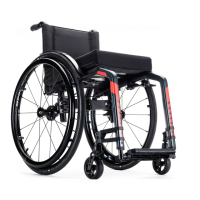Why is the front wheel stiff or stuck on my Küschall Wheelchair?
- KKimberly CareySep 7, 2025
A stiff or stuck front wheel on your Küschall Wheelchair is likely due to dirty or faulty bearings. Clean or replace the bearings.

Why is the front wheel stiff or stuck on my Küschall Wheelchair?
A stiff or stuck front wheel on your Küschall Wheelchair is likely due to dirty or faulty bearings. Clean or replace the bearings.
Why is my Küschall Wheelchair very difficult to unfold?
If your Küschall Wheelchair is very difficult to unfold, it could be because the backrest cover is too tight. Loosen the hook and loop straps of the backrest cover a little. It might also be that the folding mechanism is adjusted too hard, so adjust the folding mechanism.
Why Küschall Wheelchair does not travel in a straight line?
If your Küschall Wheelchair isn't moving straight, several factors could be at play. It might be due to incorrect tire pressure in one of the rear wheels. Unevenly tightened or broken spokes could also be the cause. The front wheel bearings might be dirty or damaged, or the rear wheels could be off track. Also, check if the bearing block of the front wheel is not in a vertical position or if the front wheels are not adjusted to the same height. Correcting the tire pressure can resolve the issue. For other causes, it is best to consult with a specialist.
Why Küschall Wheelchair rolling resistance is very high?
High rolling resistance in your Küschall Wheelchair can be due to a couple of reasons. First, check the tire pressure in the rear tires, as low pressure can significantly increase resistance. Also, ensure that the rear wheels are correctly aligned. Correcting the tire pressure can resolve the issue. For other causes, it is best to consult with a specialist.
What to do if Küschall Wheelchair brakes are gripping poorly?
If the brakes on your Küschall Wheelchair aren't gripping well, start by checking the tire pressure in both rear tires. Incorrect pressure can affect brake performance. If the tire pressure is correct, the brake setting might be incorrect. Correcting the tire pressure can resolve the issue. For other causes, it is best to consult with a specialist.
Why Küschall Wheelchair tips backwards too easily?
| Brand | Kuschall |
|---|---|
| Model | CHAMPION |
| Category | Wheelchair |
| Language | English |
Explains the meaning of symbols and signal words used in the manual for hazard identification.
Specifies the intended purpose and conditions for which the wheelchair is indicated.
Provides details of the limited warranty, coverage periods, and terms for the wheelchair.
Contains crucial safety information for the user and assistant for safe operation of the wheelchair.
Warns about using non-Küschall accessories and the risks involved.
Explains factors affecting wheelchair stability and the need for qualified technician adjustments.
Advises against transporting users in wheelchairs in vehicles and recommends proper transfer methods.
Provides critical operating guidelines for safe use, including bending, reaching, and tipping precautions.
Emphasizes the importance and proper use of seat positioning straps for user safety.
Highlights severe risks including fire hazards and injury from improper use or adjustments.
Details safety precautions related to wheel locks, hand grips, and tire information.
Explains the importance of safety devices and the information provided on product labels.
Provides a visual overview of the wheelchair's main components and a brief description.
Explains the function of wheel locks and provides instructions for engaging and disengaging them.
Details how to adjust the tension of the backrest cover and associated tipping risks.
Explains how to remove, install, and adjust the height of the armrests.
Explains the function of antitippers and recommends their use for user safety.
Provides information on ideal tire pressure, tire types, and the need for qualified technicians for tire changes.
Describes the use of the securing strap to keep the wheelchair folded during transport.
Explains the function of the seat positioning strap to prevent sliding and falling out, with safety warnings.
Explains the use of transit wheels for narrow applications and associated warnings.
Provides safety precautions before using the wheelchair, including checking its condition and functions.
Emphasizes safety and handling for both user and assistant, practicing techniques, and safe terrain use.
Addresses stability, balance, not lifting by detachable parts, checking hand grips, and using antitippers.
Discusses techniques for reaching, leaning, and bending while maintaining stability and balance.
Warns against tipping without assistance and proper lowering of front casters.
Provides detailed procedures and warnings for moving wheelchairs up or down stairs.
Gives instructions and precautions for safe transfers between the wheelchair and other seats.
Explains how to stop the wheelchair safely using handrims and wheel locks.
Contains warnings about securing the wheelchair during transport and risks of unsecured parts.
Provides instructions and safety precautions for folding and unfolding the wheelchair.
Details the process for removing and installing rear wheels, with overturning risk warnings.
Includes safety warnings and outlines a schedule for regular checks and maintenance tasks.
Provides guidance on visual checks, cleaning, and inspecting key components like bolts and spokes.
Emphasizes the need for professional inspection after impacts and annual safety checklists.
Details weekly and monthly inspection and adjustment tasks for wheelchair components.
Provides instructions for regular cleaning and disinfecting of the wheelchair to maintain its condition.
Safety precautions and recommendations for identifying and repairing faults, emphasizing professional help.
A table listing common faults, their possible causes, and recommended actions for repair.
Provides important instructions and warnings regarding the proper storage of the wheelchair.
Outlines steps for reuse and advises contacting authorities for proper disposal.
Lists the dimensions and weight specifications for the wheelchair, varying by configuration.
Specifies the acceptable environmental conditions, particularly temperature limits, for the wheelchair.
Details the materials used in the construction of the wheelchair components.
Presents technical data as per RESNA WC-1:2009 standards, including stability and testing requirements.